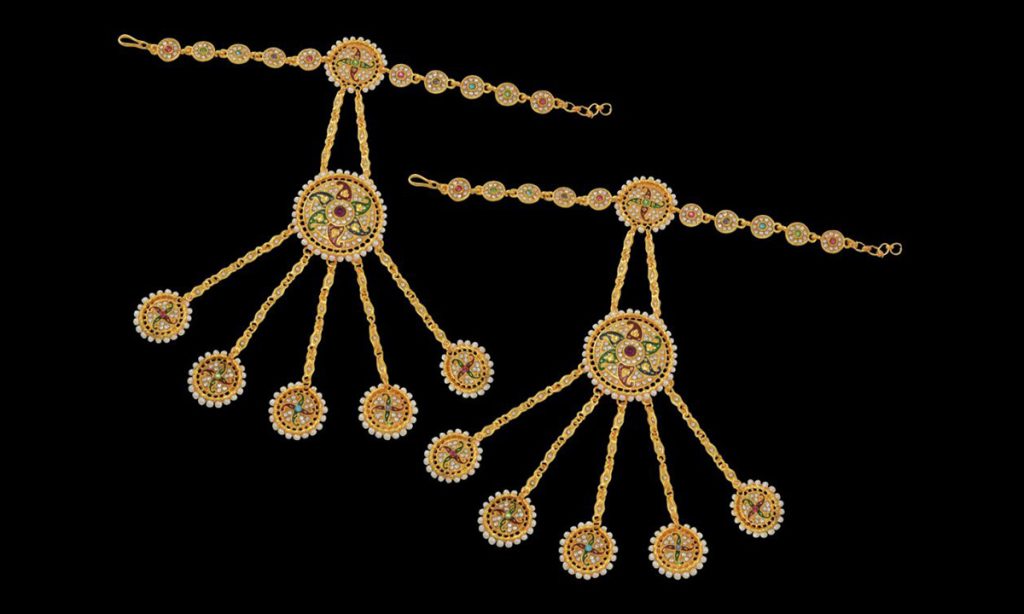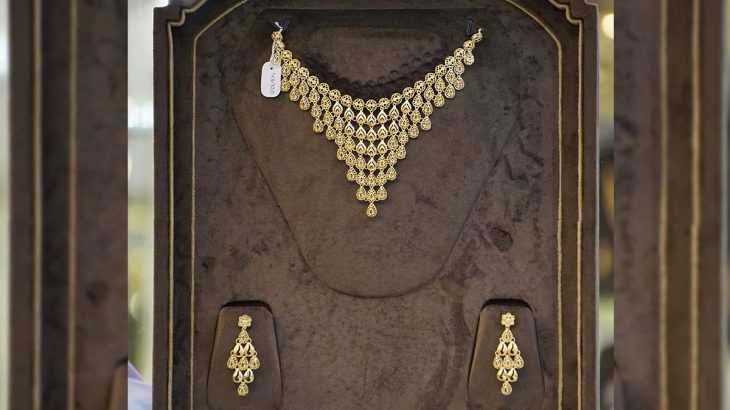To explore the varieties of jewellery with the help of a jewellery design course online is to feel as if you’ve stepped into a dream, a brilliant shiny world that stretches to and beyond the horizon.
A jewellery design course online is one of the most loved and opted fields of study among youth. A jewellery design course is not only insightful but also a medium to earn lots of money. People get into this field out of a passion for their work but many of these enthusiasts later set up their own jewellery making businesses. With the help of a jewellery design course online, you can create trendy earrings, bracelets, rings, necklaces, etc. You can also learn about the different types of traditional jewellery such as the ones mentioned below-
1) Sarpech
This sarpanch of Rajasthan is without diamonds and long emerald drops. It is topped by a paisley crest. The enamel work of Jaipur is elaborately covered on the back of the jewellery.

source: Pinterest
The head ornaments worn by women as tiaras can be seen 2000 years ago on the wall paintings at Ajanta. Although sarpanch or sarpech, meaning ornamentation for the head, evolved in mediaeval India as an ornament worn over the majestic turban, it reached perfection in the court of the Mughals and the princes of Rajasthan. Mogul queens also wore a similar jewel but by and large, it developed into a piece of predominantly male turban jewellery.
The use of uncut stones in jewellery was popularised by the Mughal emperors in the north, those who admired the precious stones in their pristine and pure form.
Enamelling reached the pinnacle of perfection in Jaipur. Maharaja Man Singh brought five Sikh enamel workers from Lahore in the 16th century to develop this art.
With Hunar Online, learn a cad jewellery design course online from the comfort of your home and in the language of your choice.
2) Kada
In this pair of kadas (karas or bracelets) from Varanasi (Banaras), the interior of each Kada is decorated with pink enamel flowers which is the speciality of Varanasi and are quite rare.
Each of the cut ends on the outer side is studded with diamonds which are embellished with intertwined trunks of elephants.
According to online jewellery courses, Jahangir was a stone bracelet from the court of Emperor Jahangir, probably designed by his queen Nur Jahan herself.
Kada can be hollow, solid or filled with lacquer. The ends of the Kada were of different designs like two parrots, twin elephants etc. The kadas made of stone are often covered with enamel on one side, the commonly used method is Champawat. The goldsmith engraves the design on the jewellery set after which the enamel is painted or brushed into the hollow. It is then fixed in place by the fire making jewellery designing a very difficult art.
3) Nose ring
This Uttam Nath, or nose-ring of Maharashtra, is set in flower-shaped clusters of diamond pearls, which are further embellished by a single ruby bead.
According to the cad jewellery design course online, there are different types of nose ornaments. There is a single stone and clove-shaped laong worn on one side of the nose, the jewel is worn through the cartilage in the centre of the nose, and bulk and nose ring of various shapes and designs. One of the most beautiful, however, is the Nath of Maharashtra.
Hardly anyone finds any reference to nose ornaments in ancient Hindu texts, from which it appears that they may have been brought into the country by Muslims in the 9th or 10th century.
However, over the past few centuries, the nose ornament has become a part of the bride’s outfit and a truly married woman cannot be without it. The blessing for the bride was often, “You can never be a widow.”
4) Karanphool jhumka
This old Karanphool Jhumka is from Rajasthan (Karanphool means a flower for the ear).
It is set with uncut pearls, diamonds and cabochon rubies. Two strands of pearl are carried around the ear to support the weight of the jewel. The projection on the rear is also aimed at attaching it to the hair to reduce weight on the ear.
The most popular ornament for ears in the north is the Karanphool with a flower motif in the centre of the ornament. According to online jewellery courses, jhumkas in the shape of a bell are also worn separately. However, it was only during the Mughal period, that the Karanphool jhumka developed as a single ornament for the ear, each region having its own special ornamentation that was added to the original design.
5) Shenka
Peacocks are attached to heavy gold chains in this ancient shenka of Gujarat. A symbol of beauty and grace, the peacock is depicted here with amethyst, emerald and ruby. Turquoise stones make for the central pieces. Small golden bells on which clusters of pearls hang, add to the beauty of the jewel.
According to the cad jewellery design course online, shinka is an unusual hair ornament from Gujarat. Although popular with some communities, it is quite rare and also the most common hair ornament being worn on the brow bone in front of the hairline.
However, the shinka is worn on the hair itself and it is a heavy ornament which is held in place by the unusual method of a gold hook attached to the hair. Newly married daughters of the family wear it at weddings and on festive occasions.
6) Hathphool

source: beendani
This Hathphool (or flower for the hand), sometimes also called Panchangala (or Jewel for five fingers), is from Rajasthan. It consists of a Kundan-set flower-attached bracelet and stone chain, which leads to another flower on the back of the palm and a similar chain connects it to five rings on the five fingers of the hand, each ring with a different flower motif. The back of the jewellery is covered with enamel designs. There is a mirror on the left thumb, which is held by the wearer for a last-minute look!
The setting of stones known as Kundan is used by small pits carved in front of the stone-shaped ornament. According to online jewellery courses, precious stones are installed in these kiosks and are held in place by a band of pure gold.
There is intricate enamelling of different colours on the back of this jewellery. The hands of the wearer are decorated with mehndi designs, which is an essential decoration for the bride of the north and which is itself a work of art.
Whether on a festive occasion or a wedding ceremony, casual event or a serious date, the above-mentioned traditional jewellery pieces, taught about in jewellery design courses online, are timeless and elegant.
Also Read: South Indian Jewellery Design: 10 Famous Necklaces
At Hunar Online, you will get access to detailed video lessons and can learn from anywhere. You will get 24/7 faculty support and a chance to learn from the experts in the industry. You can also watch our trial classes and get a glimpse of our courses. You can start learning your favourite course by downloading the app.
So, what are you waiting for? Join Hunar Online Courses and do what you always wanted to do.



